Thule Transporter Combination Hitch cargo box review
A few months ago, I got a Thule Transporter 665C Combi Hitch cargo box. It’s kind of like a roof-mounted cargo box, but it hooks to a receiver hitch.
Background
I needed something to carry my hockey gear for this trip. I could have fit everything in Sam‘s cargo area, but hockey gear tends to stink, and I didn’t want my car to smell like a locker room. An external solution was needed.
I considered several roof-mounted cargo boxes from Thule and Yakima, but there were many problems with those solutions. First, roof-mounted boxes adversely impact gas mileage, and I didn’t want to have even a 1 mpg hit over the 30,000 miles I planned to drive. Second, a roof-mounted box would have limited my parking options, since it would add quite a bit of height to an already high car. Third, I didn’t want to hoist my hockey gear bag up so far, since it can weight close to 70 pounds when wet and is awkwardly bulky.
When I saw this Thule hitch-mounted cargo box, I knew I had found my solution.
As I write this, I’ve been using the 665C Transporter continuously for six months and have logged over 31,000 miles with it on the back of my Outback. These are my first-hand impressions.
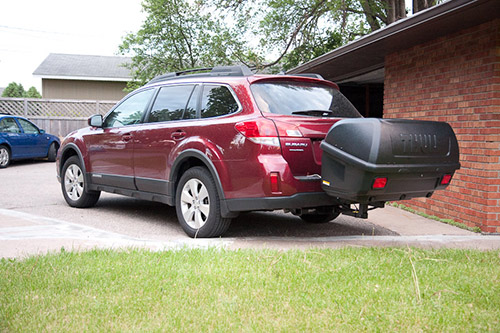
Thule Transporter Combination Hitch 665C cargo box
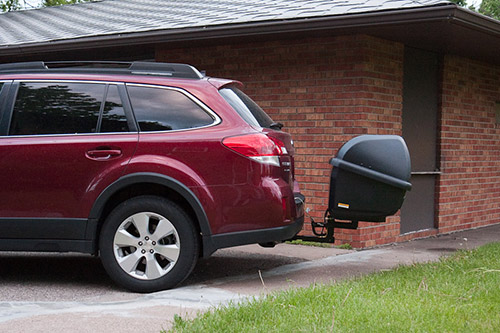
Another view of the Thule 665C cargo box
The Good
- The lights work well. The cargo box comes with built-in tail and license-plate lights. They hook up like normal trailer lights.
- Mounts to both 1.25″ and 2″ receiver hitches. I have an aftermarket 2″ receiver hitch on my Subaru, but even if I had the factory 1.25″ hitch, I would have been able to use this cargo box.
- Big enough to fit a hockey goalie gear bag. Just barely, but the bottom line is that it does fit. Unfortunately, it is not wide enough to accommodate my hockey sticks, so those ride in the passenger cabin.
- Good at keeping out water. The cargo box isn’t weather sealed per se, but it has a generous lip at the intersection of the top and bottom halves, and I haven’t had any problems with water entering the interior of the box.
- Price is comparable to a roof-mounted box. If you don’t have a hitch on your car, that would add a few hundred dollars to the total cost, but the box alone is about the same price as a mid-range roof-mount box.
- Easy to access contents of the box. The box opening is at waist level, so it’s as easy to access as things in a car trunk. This has been particularly useful for my hockey goalie gear, since the bag is large and unwieldy. I have no trouble getting the bag into and out of the box.
- Easily mounted with one person. The cargo box weighs about 75 pounds, and I can easily mount and remove it by myself.
- Can still open the wagon’s hatch. The cargo box folds back while mounted on the car, and when folded back, the car’s wagon hatch opens without any restriction.
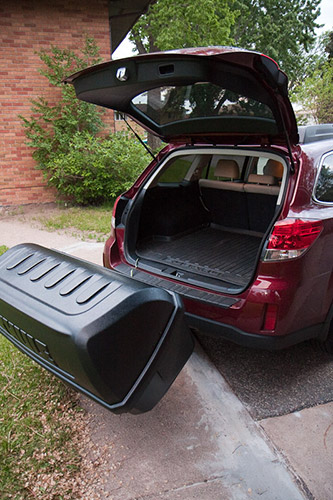
The Outback's wagon hatch opens easily when the Thule Combi-Hitch box is tilted back
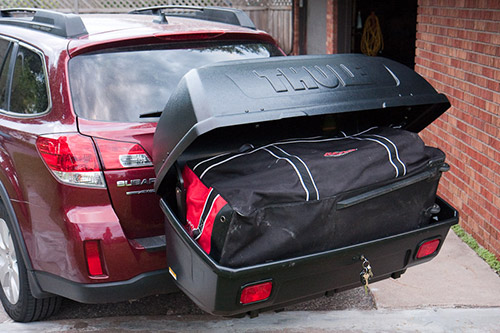
The Thule 665C cargo box holds my hockey goalie gear, if just barely
The Bad
- Can be difficult to close. When the box is packed very full, it can flex a bit, and if that happens, it’s very difficult to latch the lock.
- Flops around a lot. At freeway speeds, the box will bounce around and shake a bit, even when fully loaded and even when the special bolt-pin is tightened down.
- Sits askew on the hitch. I’m not sure whether the box’s frame is bent or if it’s that the box itself is mishapen, but for whatever reason, the box leans to the driver’s side when mounted in the receiver hitch. It leans even when empty. For a little while, I thought the receiver hitch itself was bent, but further measurement showed that the fault was with the cargo box. The lean isn’t bad — just a few degrees — but it is noticeable.
- License plate mount faces down. The license plate mount is angled downward, so it’s hard to see the license plate from behind. I resorted to bending the license plate itself so that it would be readable from behind.
- Reduces angle of attack. I now have to pay close attention to the angles of driveways, because if I have the cargo box mounted and go to a steep angle transition, the box will scrape the pavement. Even when I’m careful, I scrape every once in a while.
- Blocks rear-view camera. My Outback has a built-in rear-view camera. However, it is obscured by the cargo box, so it becomes useless when the cargo box is mounted on the car.
- Front-end raises up. When the cargo box is loaded with my hockey gear, the weight and leverage push the back of my car down and the front up. That’s only really an issue at night, when my headlights aim up into oncoming drivers’ eyes.
- Fold-down mechanism can be difficult to latch and release. The cargo box can be folded down by releasing a pin and lifting a lever. In theory, the weight of the box should rest on the lever, and the safety pin should ordinarily bear no weight. In practice, the safety pin bears all the weight when inserted, and the lever bears no weight. Since all of the weight is on the pin, it can be difficult, sometimes very difficult, to insert and remove the pin. I’m forced to lift up on the box itself and rock it back and forth until the holes are aligned for the pin to go in. This is a significant design flaw and the most annoying problem with the entire box. UPDATE: This turns out to be a matter of technique. If you reverse the latching order, so that you wait to engage the main lever until after inserting the safety pin, the safety pin becomes very easy to insert. Likewise, if you disengage the lever before trying to remove the pin, the pin becomes very easy to remove. This discovery made my enjoyment of the Thule cargo box go up by at least 50%.
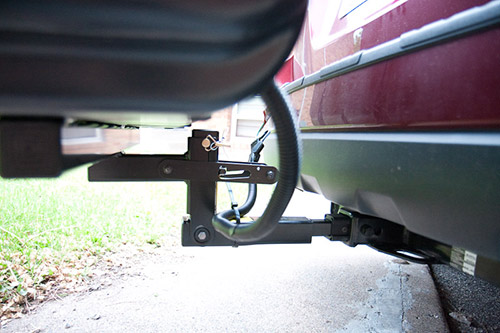
The Thule 665C combi-hitch will tilt back using this mechanism. If only the safety pin served as a secondary restraint instead of a primary restraint.
Conclusion
This is a great cargo box. I’ve been satisfied with its cargo-holding performance and recommend it.


Hi,
Are you still using the Thule box on your Outback? I am down sizing from a Chevy Tahoe to a 2016 Outback and will need the extra storage for trips with the family. Wow , did you drive 30K miles in 6 months , you would most certainly have already traded it by now.. 😉 Happy New Year !
Brian
Stuarts Draft, Va